Pentatonic scale bass TAB and patterns: learn how to play pentatonic scales on bass guitar.
Page Index
- Introduction: The Pentatonic Minor Scale
- Why Learn Pentatonic Scales on Bass Guitar?
- Pentatonic Scale Bass TAB: Open Position
- E Pentatonic Scale Bass TAB
- G Pentatonic Scale Bass TAB
- A Pentatonic Scale Bass TAB
- B flat Pentatonic Scale Bass TAB
- C Pentatonic Scale Bass TAB
- D Pentatonic Scale Bass TAB
- Movable Pentatonic Scale Bass Patterns
- Pentatonic Scale Bass Pattern 1
- Pentatonic Scale Bass Pattern 2
- Pentatonic Scale Bass Pattern 3
- Pentatonic Scale Bass Pattern 4
- Pentatonic Scale Bass Pattern 5
- How To Use Movable Bass Scale Patterns
- Why Do The Scale Patterns Contain Additional Notes Outside Of The Tonic Notes Of The Scales?
- Learn more bass scales with Guitar Command
Also on Guitar Command:
Want to learn more bass scales, plus arpeggios and chords? Check out our comprehensive downloadable reference ebook: Bass Scales, Chords & Arpeggios.
Practice playing and improvising with bass scales with our specially-produced bass backing tracks: Bass Scales Backing Tracks & Bass Modes Backing Tracks.
Play pentatonic scale on bass guitar
Play blues scales on bass guitar
Introduction: The Pentatonic Minor Scale For Bass Guitar
Although the name ‘pentatonic scale’ can be used for any five-note scale, in rock, pop and jazz music it most commonly refers to the pentatonic minor scale, which is the scale we’ll be covering on this page.
(Unless specified, whenever we mention ‘pentatonic scale’ on this page, we’ll be referring to the pentatonic minor scale.)
- Another commonly-used pentatonic scale is the major pentatonic You can find out how to play the major pentatonic scale at our main bass scales page: Bass Scales
Why Learn Pentatonic Scales on Bass Guitar?

The pentatonic scale is one of the first scales a bass guitarist should learn. It not only sounds great, but it’s also easy to play and very versatile, being used in a wide range of musical styles.
You can use the pentatonic scale when making up basslines, riffs and melodies, and also when improvising bass solos.
Pentatonic Scale Bass TAB: Open Position
In this section you’ll find TABs for playing the pentatonic scale in open position* in a number of common keys.
You’ll find movable pentatonic scale bass patterns, which can be moved up and down the fretboard in order to play the pentatonic scale with any tonic note, in the next section.
* In guitar, ‘open position’ generally means that the fretting hand is positioned at the headstock end of the neck, ready to play notes at the 1st to 4th frets. When playing in this position, ‘open’ (i.e. unfretted) strings are often used.
E Pentatonic Scale Bass TAB

When playing E pentatonic scale as shown in the TAB above, you’re essentially using pattern 1 from the movable scale patterns section of this page, but with open strings in place of some of the fretted strings marked in the pattern.
G Pentatonic Scale Bass TAB

A Pentatonic Scale Bass TAB

B flat Pentatonic Scale Bass TAB

The TAB above shows how movable pattern 4 can be used at the 1st fret in order to play a B flat pentatonic scale.
C Pentatonic Scale Bass TAB

You’ll have to change fretboard position as you play in order to reach the higher notes of this scale.
D Pentatonic Scale Bass TAB

As with the C pentatonic TAB above, you’ll have to change fretboard position as you play in order to reach the higher notes of this scale. Example fingering for the fretting hand has been provided.
Movable Pentatonic Scale Bass Patterns
You won’t always be playing in the first four frets; sometimes your basslines and solos will take you higher up the neck. This is when movable bass scale patterns come in handy.
By learning any one of the following movable pentatonic scale bass patterns, you’ll be able to play the scale with any tonic note* by moving the pattern to the desired position on the fretboard.
* The ‘tonic note’ of a scale is the first note of the scale, and the note in the scale’s name, i.e. the ‘C’ in a C pentatonic scale, or the ‘F’ in an F major scale.
Pentatonic Scale Bass Pattern 1
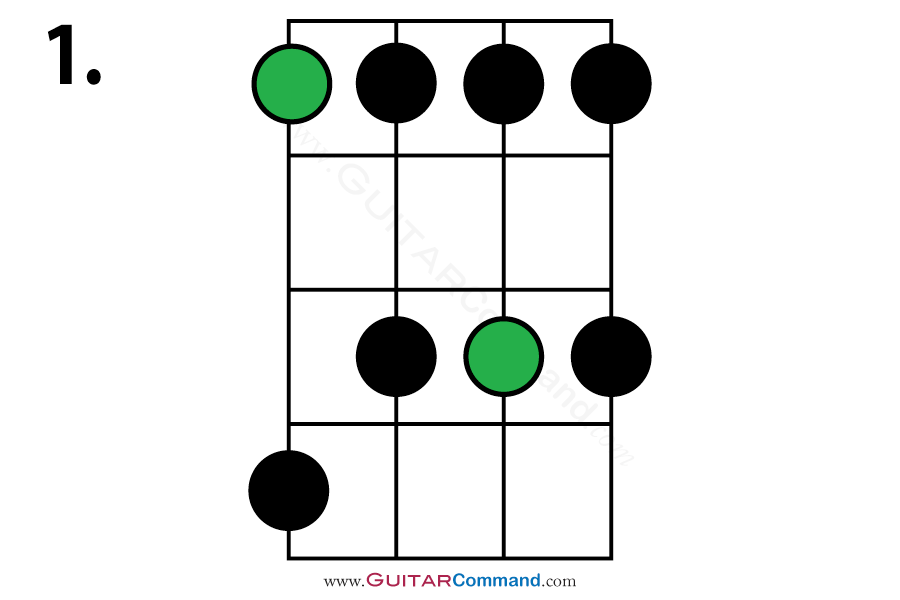
Pentatonic Scale Bass Pattern 2
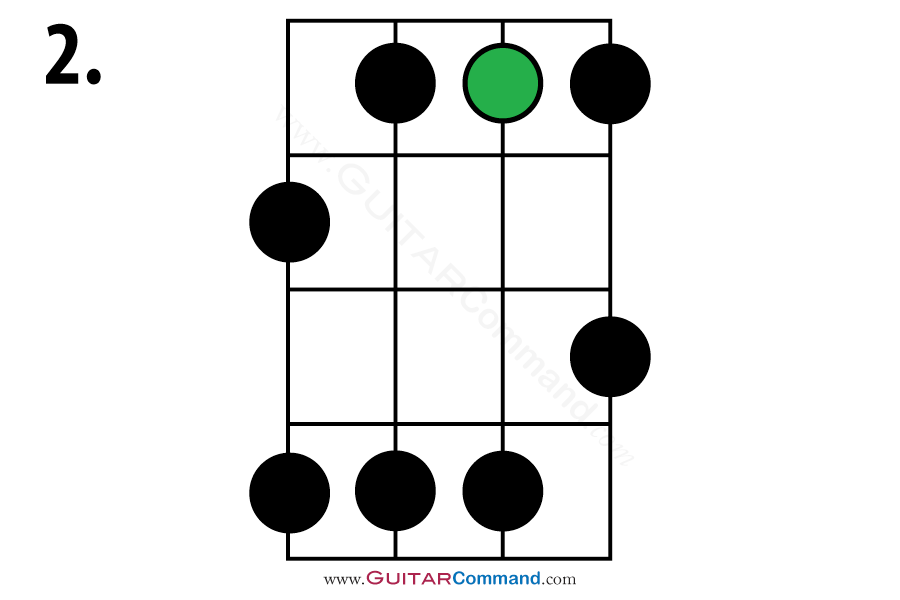
Pentatonic Scale Bass Pattern 3
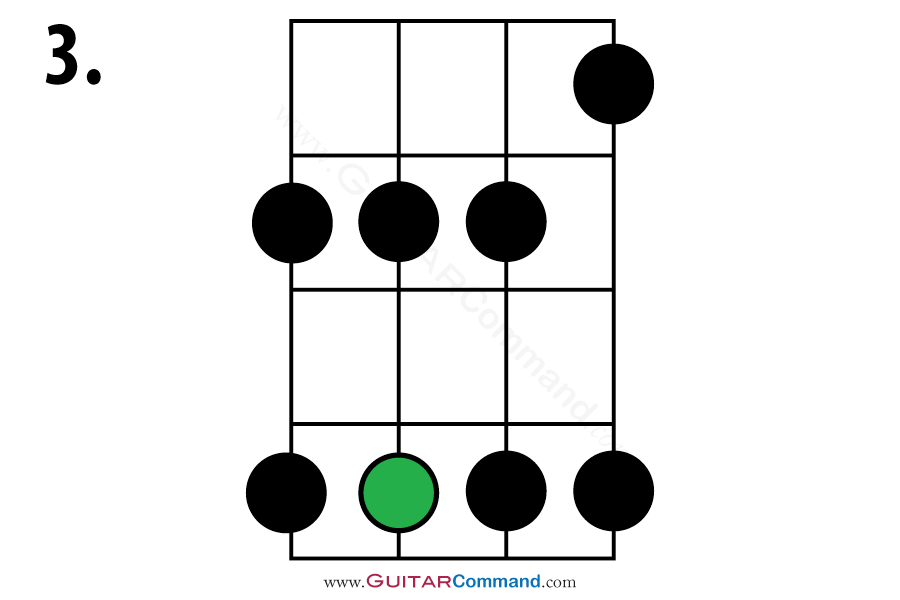
Pentatonic Scale Bass Pattern 4
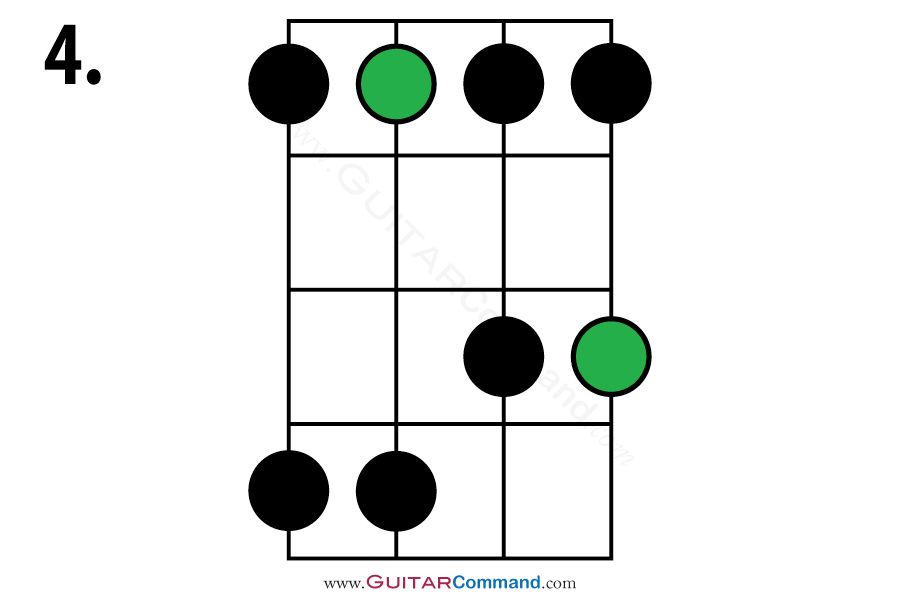
Pentatonic Scale Bass Pattern 5
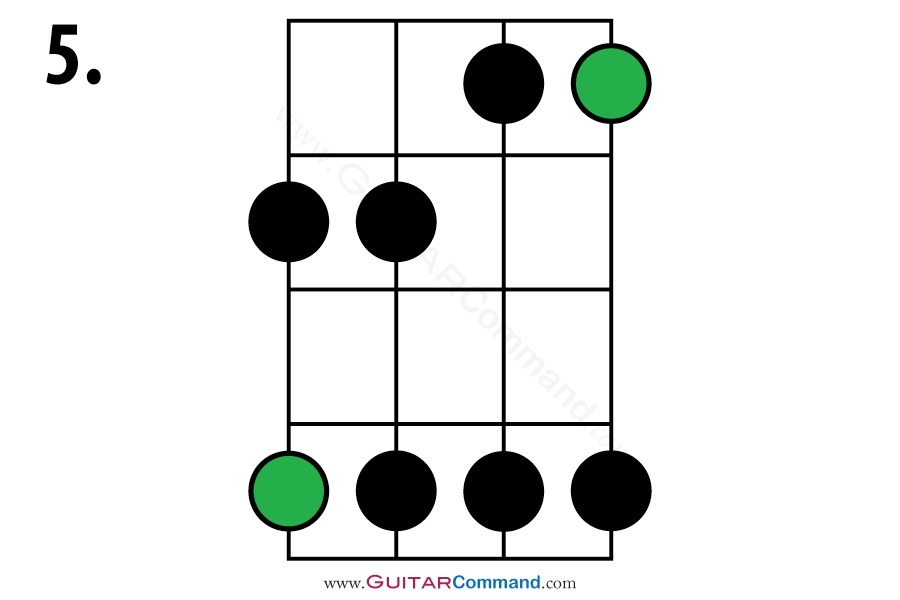
How To Use Movable Bass Scale Patterns
The tonic notes in the scale patterns are represented by green circles. Position your fretting hand so that the fingers are over the correct note on the fretboard and play the scale as indicated by the pattern.
For example, play a G pentatonic scale using pattern 1 by playing the scale at the 3rd fret (where the first green circle of the pattern corresponds to the G at the 3rd fret of the low E string.
The following TAB shows how this is done.

You could use the same pattern to play an F pentatonic scale by moving your hand two frets down so that the green notes on the pattern correspond to F notes on the fretboard. This is shown in the TAB below.

Play the same pattern at the 5th fret for an A pentatonic scale, and so on, simply changing your fretboard position to the desired tonic note.
Why Do The Scale Patterns Contain Additional Notes Outside Of The Tonic Notes Of The Scales?
Be aware that scale patterns contain additional notes that extend the scale beyond the tonic notes. If you just want to play the scale, play up from the first green note to the second – this will result in a one-octave pentatonic scale.
The extra notes are provided in case you’re using the scale pattern for improvising a solo or writing a bass riff. In these cases you won’t want to be limited to just playing in one octave; the extra notes allow you to go beyond the tonic notes and even join up two or more patterns to create multi-octave lines.
Patterns 2 and 3 don't contain two tonic notes and therefore can't be used to play the pentatonic scale over an entire octave. Although you won't be able to play an entire scale with these patterns, they're still useful for improvising & writing with. You can also join them up with other patterns by changing fretboard position as you play. This will allow you to create long, flowing lines.
Learn more bass scales with Guitar Command
Visit our main scales page to discover more awesome scales: Bass Scales
Play pentatonic scale on bass guitar
Play blues scales on bass guitar
Want to learn more bass scales, plus arpeggios and chords? Check out our awesome downloadable reference book: Bass Scales, Chords & Arpeggios.
Practice playing and improvising with bass scales with our specially-produced bass backing tracks: Bass Scales Backing Tracks & Bass Modes Backing Tracks.



Hi… I’m a five string banjo guy…picking up bass guitar.
Am unfamiliar with the green/black patterns. I think I understand the first pattern..starting with green…up to second green. But, unsure of pattern 2with only one green. Is that an up/down choice??
The green dot is the root note you’re using